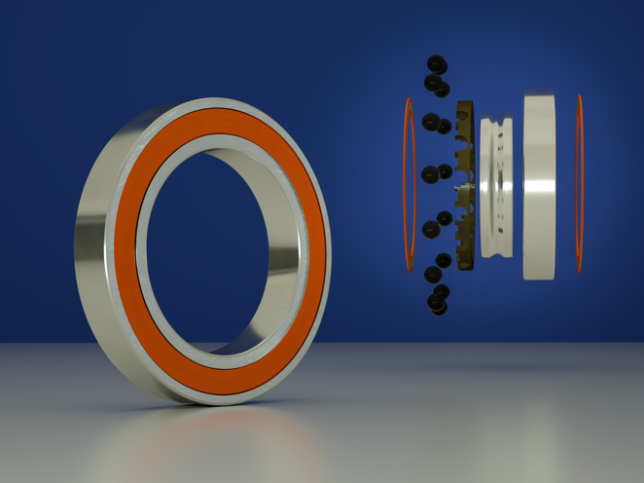CERAMIC BEARINGS
CERAMIC BEARINGS OFFER BETTER PERFORMANCE THAN STEEL, AND RESISTANCE TO HIGH TEMPERATURE, CORROSION AND WEAR

By Jason Flanzbaum
The main purpose of bearings is to provide a low-friction but stiff mechanical contact between stationary and rotating machinery parts. Ideally, a bearing should provide low resistance to rotational movement, while impeding movement in the radial and axial directions. They must also be able to resist moment loads and bending.
Forces are spread across many contact points on bearings used in cylindrical rollers or balls. Turbomachinery typically uses a combination of both rollers and balls, where the bulk of radial forces is resisted by rollers, while ball bearings resist most of the axial load.
For high-speed turbomachinery applications, ceramic bearings offer better performance than conventional steel bearings. This is due to their resistance to high temperature, corrosion and wear caused by high RPMs (anything exceeding 90,000).
Silicon nitride (Si3N4) is one of the most promising materials in ceramic bearing applications. It is harder than steel, and its hardness is not affected significantly as the temperature increases. Performance can be enhanced further with hybrid bearings, which use ceramic balls and steel races, a combination that minimizes rolling friction and wear.
Some bearings use a fluid film instead of rollers or balls, but their application in turbomachinery is limited. Fluid bearings provide less stiffness while requiring more space than ball or roller bearings, and must be supplied with pressurization. Even if pressurization is accomplished by the turbomachinery itself, a secondary source is required during startup.
Steel bearings
Engine size and weight reduction are some of the chief development priorities in the aerospace industry. Airplanes and spacecraft typically consume more fuel to fly their own weight than what is needed to carry their crew or payload. Jet engines are among their most heavy components.
As RPM increases, jet engine size and weight decrease as more impulse can be produced for a given engine size. In addition, high temperature improves the thermodynamic efficiency and fuel economy of turbomachinery. However, high speed and temperature create the need for better materials. Bearings represent one of the primary bottlenecks, limiting design speed and operating temperature.
The aerospace industry can benefit from the use of bearings that tolerate higher speed and temperature. Engines can become lighter and more efficient, while reducing maintenance costs and extending service life.
Steel bearings offer satisfactory performance at lower speeds and temperatures, but become more malleable at the high operating temperatures, such as in jet engines. The high rotational speed in jet engines accelerates wear. This is compounded by the fact that lubrication is depleted at a faster rate by high-speed turbomachinery. Ceramic bearings, particularly hybrid ones, have emerged as a more promising alternative to steel bearings.
Silicon nitride bearings
Silicon nitride (Si3N4) ceramic bearings are manufactured through a process called hot isostatic pressing (HIP), where a ceramic in powder form is subjected to high temperature and pressure in the presence of an inert gas, such as argon. Bearings manufactured with HIP have a minimal occurrence of surface defects and internal pores, increasing their resistance to fatigue and fracture.
Si3N4 has more wear resistance than steel. It has a hardness of 90 HRC (Rockwell C scale), while the hardest tool-grade steels are typically below 70 HRC. Si3N4 preserves hardness at high temperatures, while steel becomes more ductile and susceptible to deformation.
Si3N4 also has only one-third the density of steel. This enables the manufacture of lighter bearings and lower weight, as well as increased bearing stiffness. Unlike steel, Si3N4 does not conduct electricity. In applications where electrical isolation is required between the rotor and stator, ceramic bearings can perform a double function.
There are, of course, limitations. While its hardness raises wear resistance, Si3N4 is stiff and provides poor damping. This makes it unsuitable for applications where the rotor is subject to impact loads. Its rigidity may mean that failure is less likely than with steel.
However, once failure occurs, it is rapid due to silicon nitride’s lack of tolerance to deformation. Steel also has a greater tolerance to surface defects, which are worn down as the bearing rolls. A surface defect in a ceramic bearing may lead to cracks and other issues. Finally, many current nondestructive test methods depend on magnetism and conductivity. They cannot be implemented in the presence of non-conducting ceramics.
Future possibilities
Silicon carbide (SiC) is another promising bearing material. It offers a hardness of 2,800 kg/mm2, which is higher than that of silicon nitride (1,580 kg/mm2). It is outclassed only by diamond and a handful of other substances. Further, silicon carbide offers the highest resistance to temperature and corrosion among all ceramic materials used in bearings. Its main limitation is the difficulty and cost of manufacturing.
Although SiC bearings have already been manufactured with sintering and HIP, control of surface defects and internal pores has proven to be a significant challenge. One alternative that has been proposed is to create a ceramic matrix composite (CMC) through vapor deposition.
Crystalline silicon carbide is deposited on fibers of the same material with the use of a processing gas, eventually growing the material into the desired shape. The process remains and expensive, but offers high accuracy when manufacturing SiC components.
Author: Jason Flanzbaum is President and CEO of Boca Bearings, a company delivering ceramic technologies to market. It stocks a full range of ceramic
balls, hybrid bearings and full bearings for all industrial, medical, and specialty applications. For more information, visit
www.BocaBearings.com